NCERT Solutions | Class 11 Maths Chapter 12 | Introduction to three-dimensional geometry

CBSE Solutions | Maths Class 11
Check the below NCERT Solutions for Class 11 Maths Chapter 12 Introduction to three-dimensional geometry Pdf free download. NCERT Solutions Class 11 Maths were prepared based on the latest exam pattern. We have Provided Introduction to three-dimensional geometry Class 11 Maths NCERT Solutions to help students understand the concept very well.
NCERT | Class 11 Maths
| Book: | National Council of Educational Research and Training (NCERT) |
|---|---|
| Board: | Central Board of Secondary Education (CBSE) |
| Class: | 11th |
| Subject: | Maths |
| Chapter: | 12 |
| Chapters Name: | Introduction to three-dimensional geometry |
| Medium: | English |
Introduction to three-dimensional geometry | Class 11 Maths | NCERT Books Solutions
NCERT Solutions for Class 11 Maths Chapter 12 Introduction to Three Dimensional Geometry Ex 12.1
Ex 12.1 Class 11 Maths Question 1.
A point is on the x-axis. What are its y-coordinate and z-coordinate?
Solution.
The coordinates of any point on the x-axis will be (x, 0, 0). Thus y-coordinate and z-coordinate of the point are zero.
Ex 12.1 Class 11 Maths Question 2.
A point is in the XZ-plane. What can you say about its y-coordinate?
Solution.
The coordinates of any point in XZ-plane will be (x, 0, z). Thus y-coordinate of the point is zero.
Ex 12.1 Class 11 Maths Question 3.
Name the octants in which the following points lie:
(1, 2, 3), (4, -2, 3), (4, -2, -5), (4, 2, -5), (-4, 2, -5), (-4, 2, 5), (-3, -1, 6), (2, -4, -7)
Solution.
Point (1, 2, 3) lies in Octant I.
Point (4, -2, 3) lies in Octant IV.
Point (4, -2, -5) lies in Octant VIII.
Point (4, 2, -5) lies in Octant V.
Point (- 4, 2, -5) lies in Octant VI.
Point (- 4, 2, 5) lies in Octant II.
Point (- 3, -1, 6) lies in Octant III.
Point (2, – 4, -7) lies in Octant VIII.
Ex 12.1 Class 11 Maths Question 4.
Fill in the blanks:
(i) The x-axis and y-axis taken together determine a plane known as ______
(ii) The coordinates of points in the XY-plane are of the form _______
(iii) Coordinate planes divide the space into ______ octants.
Solution.
(i) XY-plane
(ii) (x, y, 0)
(iii) Eight
NCERT Solutions for Class 11 Maths Chapter 12 Introduction to Three Dimensional Geometry Ex 12.2
Ex 12.2 Class 11 Maths Question 1.
Find the distance between the following pairs of points:
(i) (2, 3, 5) and (4, 3, 1)
(ii) (-3, 7, 2) and (2, 4, -1)
(iii) (-1, 3, -4) and (1, -3, 4)
(iv) (2, -1, 3) and (-2, 1, 3)
Solution.
(i) The distance PQ between the points P(2, 3, 5) and Q(4, 3, 1) is
\(PQ=\sqrt { \left( 4-2 \right) ^{ 2 }+\left( 3-3 \right) ^{ 2 }\left( 1-5 \right) ^{ 2 } } \)
= \(\sqrt { 4+0+16= } \sqrt { 20 } =2\sqrt { 5 } units.\)
(ii) The distance PQ between the points P(-3, 7, 2) and Q(2, 4, -1) is
\(PQ=\sqrt { \left[ 2-\left( -3 \right) \right] ^{ 2 }+\left( 4-7 \right) ^{ 2 }\left( -1-2 \right) ^{ 2 } } \)
\(=\sqrt { \left( 2+3 \right) ^{ 2 }+\left( 4-7 \right) ^{ 2 }+\left( -1-2 \right) ^{ 2 } } \)
\(=\sqrt { 25+9+9 } =\sqrt { 43 } units\)
(iii) The distance PQ between the points P(-1, 3, -4) and Q(1, -3, 4) is
\(PQ=\sqrt { \left[ 1-\left( -1 \right) \right] ^{ 2 }+\left( -3-3 \right) ^{ 2 }\left[ 4-\left( -4 \right) \right] ^{ 2 } } \)
\(=\sqrt { 4+36+64 } =\sqrt { 104 } =2\sqrt { 26 } units\)
(iv) The distance PQ between the points P(2, -1, 3) and Q(-2, 1, 3) is
\(PQ=\sqrt { \left( -2-2 \right) ^{ 2 }+\left[ 1-\left( -1 \right) \right] ^{ 2 }+\left( 3-3 \right) ^{ 2 } } \)
\(=\sqrt { 16+4+0 } =\sqrt { 20 } =2\sqrt { 5 } units\)
Ex 12.2 Class 11 Maths Question 2.
Show that the points (-2, 3, 5), (1, 2, 3) and (7, 0, -1) are collinear.
Solution.
Let A(-2, 3, 5), B(1, 2, 3) and C(7, 0, -1) be three given points.
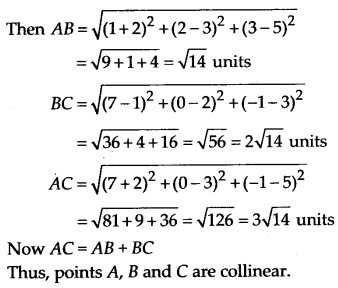
Now AC = AB + BC
Thus, points A, B and C are collinear.
Ex 12.2 Class 11 Maths Question 3.
Verify the following:
(i) (0, 7, -10), (1, 6, -6) and (4, 9, -6) are the vertices of an isosceles triangle.
(ii) (0, 7, 10), (-1, 6, 6) and (-4, 9, 6) are the vertices of a right angled triangle.
(iii) (-1, 2, 1), (1, -2, 5), (4, -7,8) and (2, -3,4) are the vertices of a parallelogram.
Solution.
(i) Let A(0, 7, -10), B(l, 6, -6) and C(4, 9, -6) be three vertices of triangle ABC. Then
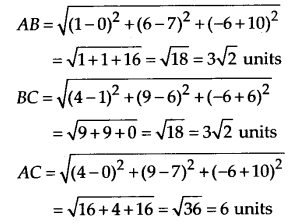
Now, AB = BC
Thus, ABC is an isosceles triangle.
(ii) Let A(0, 7,10), B(-l, 6, 6) and C(-A, 9, 6) be three vertices of triangle ABC. Then
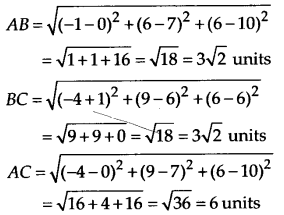
Now, AC2 = AB2 + BC2
Thus, ABC is a right angled triangle.
(iii) Let A(-1, 2, 1), B(1, -2, 5) and C(4, -7, 8) and D(2, -3,4) be four vertices of quadrilateral ABCD. Then

Now AB = CD, BC = AD and AC ≠ BD
Thus A, B, C and D are vertices of a parallelogram ABCD.
Ex 12.2 Class 11 Maths Question 4.
Find the equation of the set of points which are equidistant from the points (1, 2, 3) and (3, 2, -1).
Solution.
Let A(x, y, z) be any point which is equidistant from points B(1, 2, 3) and C(3, 2, -1).
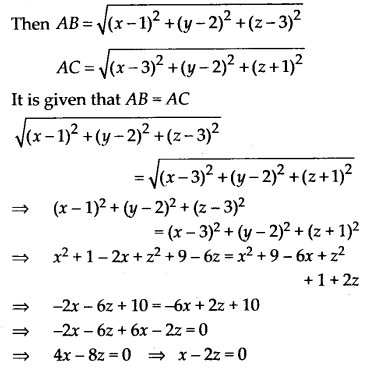
Ex 12.2 Class 11 Maths Question 5.
Find the equation of the set of points P, the sum of whose distances from A(4, 0, 0) and B(-4,0,0) is equal to 10.
Solution.
Let P(x, y, z) be any point.
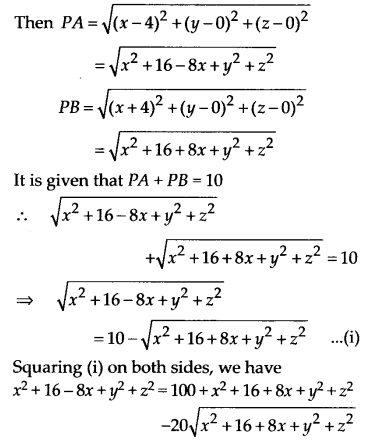

NCERT Solutions for Class 11 Maths Chapter 12 Introduction to Three Dimensional Geometry Ex 12.3
Ex 12.3 Class 11 Maths Question 1.
Find the coordinates of the point which divides the line segment joining the points (-2, 3, 5) and (1, -4, 6) in the ratio
(i) 2 : 3 internally,
(ii) 2 : 3 enternally
Solution.
(i) Let P(x, y, z) be any point which divides the line segment joining the points A(-2, 3, 5) and B(1, -4, 6) in the ratio 2 : 3 internally.

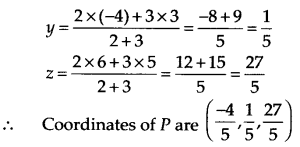
(ii) Let P(x, y, z) be any point which divides the line segment joining the points 71 (-2, 3, 5) and B(1, -4, 6) in the ratio 2 : 3 externally. Then
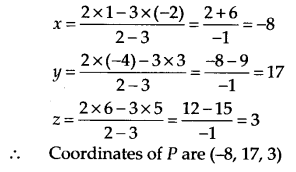
Ex 12.3 Class 11 Maths Question 2.
Given that P(3, 2, -4), Q(5, 4, -6) and R(9, 8, -10) are collinear. Find the ratio in which Q divides PR.
Solution.
Let Q(5, 4, -6) divides the line segment joining the points P(3, 2, -4) and R(9, 8, -10) in the ratio k : 1 internally.
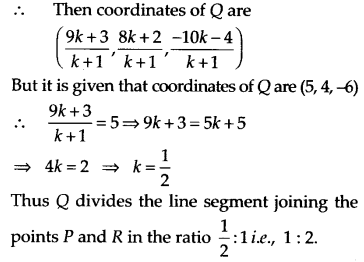
Ex 12.3 Class 11 Maths Question 3.
Find the ratio in which the YZ-plane divides the line segment formed by joining the points (-2, 4, 7) and (3, -5, 8).
Solution.
Let the line segment joining the points A(-2, 4, 7) and B(3, -5, 8) be divided by the YZ -plane at a point C in the ratio k : 1.
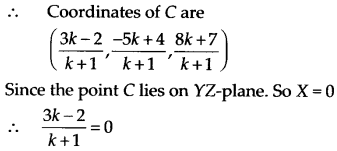

Ex 12.3 Class 11 Maths Question 4.
Using section formula, show that the points A(2, -3, 4), B(-1, 2, 1) and C\(\left( 0,\frac { 1 }{ 3 } ,2 \right) \) are collinear.
Solution.
Let the points A(2, -3, 4), B(-l, 2,1) and C\(\left( 0,\frac { 1 }{ 3 } ,2 \right) \) be the given points. Let the point P divides AB in the ratio k : 1. Then coordinates of P are \(\left( \frac { -k+2 }{ k+1 } ,\frac { 2k-3 }{ k+1 } ,\frac { k+4 }{ k+1 } \right) \)
Let us examine whether for some value of k, the point P coincides with point C.
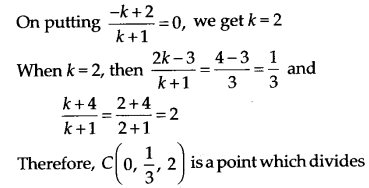
AB internally in the ratio 2:1. Hence A, B, C are collinear.
Ex 12.3 Class 11 Maths Question 5.
Find the coordinates of the points which trisect the line segment joining the points P(4, 2, -6) and Q(10, -16, 6).
Solution.
Let R and S be two points which trisect the line segment PQ.
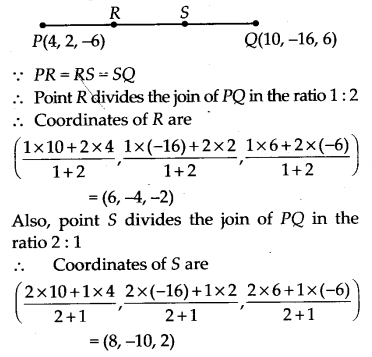
NCERT Class 11 Maths
Class 11 Maths Chapters | Maths Class 11 Chapter 12
Chapterwise NCERT Solutions for Class 11 Maths
-
NCERT Solutions For Class 11 Maths Chapter 1 Sets
NCERT Solutions For Class 11 Maths Chapter 2 Functions and relations
NCERT Solutions For Class 11 Maths Chapter 3 Trigonometric functions
NCERT Solutions For Class 11 Maths Chapter 4 Principle of mathematical induction
NCERT Solutions For Class 11 Maths Chapter 5 Quadratic equations and complex numbers
NCERT Solutions For Class 11 Maths Chapter 6 Linear Inequalities
NCERT Solutions For Class 11 Maths Chapter 7 Permutations and combinations
NCERT Solutions For Class 11 Maths Chapter 8 Binomial Theorem
NCERT Solutions For Class 11 Maths Chapter 9 Sequences and series
NCERT Solutions For Class 11 Maths Chapter 10 Straight lines
NCERT Solutions For Class 11 Maths Chapter 11 Conic sections
NCERT Solutions For Class 11 Maths Chapter 12 Introduction to three-dimensional geometry
NCERT Solutions For Class 11 Maths Chapter 13 Limits and derivatives
NCERT Solutions For Class 11 Maths Chapter 14 Mathematical Reasoning
NCERT Solutions For Class 11 Maths Chapter 15 Statistics
NCERT Solutions For Class 11 Maths Chapter 16 Probability
| NCERT Solutions for Class 12 All Subjects | NCERT Solutions for Class 10 All Subjects |
| NCERT Solutions for Class 11 All Subjects | NCERT Solutions for Class 9 All Subjects |

Post a Comment
इस पेज / वेबसाइट की त्रुटियों / गलतियों को यहाँ दर्ज कीजिये
(Errors/mistakes on this page/website enter here)